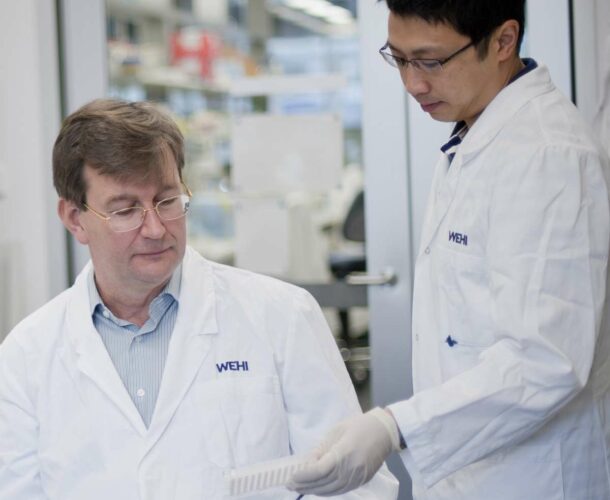In 2008, institute researchers identify and isolate the three proteins that drive autoimmunity in people with coeliac disease. This key finding enables the development of a vaccine to teach the immune system ‘tolerance’ to gluten, even if they have already developed the disease.
Dr Jason Tye-Din a clinician-scientist at the institute and a gastroenterologist at The Royal Melbourne Hospital reflects on this key discovery.
A taste for research
When he undertook his specialist training as a gastroenterologist at the Royal Melbourne Hospital, Dr Jason Tye-Din was a short walk and a million miles from where his father spent his working life as a fruiterer in the Victoria Market.
A descendent of Chinese immigrants who came to Victoria in the 1800s, Tye-Din was the first in his family to study medicine. Becoming a doctor was the realisation of a long-held ambition, but the path that led him into the challenging role of clinician-scientist was more impulsive. As any gastroenterology specialist knows, gut instinct can be powerfully instructive.
“During my first year of gastroenterology training in Canberra I got a taste of research and, to my surprise, really enjoyed it.” Tye-Din recalls.
“I caught up with an old colleague just back from Oxford, Dr Bob Anderson. Bob had made an important discovery about coeliac disease and he had just set up shop at the Walter and Eliza Hall Institute.
“I suffer from a peanut allergy, so I’ve always been interested in the relationship between food and human disease. But coeliac disease was something that in my early medical career we rarely seemed to come across,” Tye-Din says.
Coeliac disease challenge
By 2003 the condition had a much higher profile. Due to both increasing diagnosis and incidence it’s now estimated that one in 70 Australians have the condition, although 80 per cent of them will be undiagnosed. The complexity of the disease, with effects beyond the gut including infertility and osteoporosis, has only been more widely understood in recent years. At present the only therapeutic option is a lifelong strict gluten free diet.
Anderson’s major finding had been that when people ingest gluten from wheat, the immune response is detectable in the blood about six days later.
This was “a game changer”, says Tye-Din, and now Anderson wanted to exploit the insight to identify which parts of gluten were toxic.
“It fit with my interests and my medical background, and here was an opportunity to do a PhD in an emerging field, in Melbourne, with someone who had just published a landmark paper in Nature Medicine,” says Tye-Din. “Thankfully, the NHMRC allowed me to transfer my fellowship to the Walter and Eliza Hall Institute. So it all fell into place.”
A toxic trio
The project of determining precisely which proteins were the culprits in triggering disease was formidable. There are more than 18,000 gluten peptides (the building blocks that create protein) on the suspect list, so the team enlisted the institute’s bioinformatics specialists to assemble peptide “libraries”.
“By condensing the peptide libraries, bioinformatics turned an almost impossible task into something feasible. After volunteers ate gluten I would collect their blood and perform immunoassays to determine what their cells were responding to in these libraries,” says Tye-Din.
“After many years and many hundreds of patients, we were able to define exactly those peptides within wheat that were toxic.”
The project widened to go through the same process with rye, barley and oats. “For the first time we comprehensively defined the toxic gluten peptides responsible for the most common genetic form of coeliac disease.”
The holy grail
This knowledge opened the door to new approaches to improve diagnosis and, ultimately, a new treatment.
The next step required sifting through all those peptides identified as having some level of toxicity to determine which were the most problematic. The institute team narrowed the field down to three powerfully nasty players – the “toxic trio” as they were dubbed.
Now they had precise targets in their sights. “The holy grail of autoimmune disease research is to define the causative antigen in enough detail to develop targeted diagnostics and treatments.”
For coeliac disease, the toxic peptides may target and switch off the abnormal immune response to gluten, but not interfere with other protective immunological responses working in the body.
Coeliac disease vaccine
ImmusanT, a Cambridge, Massachusetts, based biotech company was established to advance this knowledge into clinical trials. It is now shaping up as the world’s first potential non-dietary immune therapy for coeliac disease. Nexvax2® is entering phase II human trials led by the US biotechnology company of which Dr Bob Anderson is now chief scientific officer. Clinical trials will be conducted in Australia amongst other countries throughout the world.
Tye-Din is closely involved in the Melbourne clinical trials with a gradually expanding Walter and Eliza Hall Institute team.
“Progress in human trials has been promising. The hope is that injections of this drug will induce a form of ‘immune tolerance’ to gluten and enable people to return to a normal diet.”
The findings have much wider potential significance, Tye-Din says. “If successful, this will be the first autoimmune disease managed by an antigen-specific therapy.” It’s hoped the suite of techniques it has developed may provide clues to treatments for other diseases such as type 1 diabetes, multiple sclerosis, and rheumatoid arthritis.
While Tye-Din’s small team continues the institute’s long tradition of frontier immunological investigation, he sees it as emblematic of the modern institute’s bench-to-bedside translational focus, strongly championed by director Professor Doug Hilton. The coeliac team is a major user of the Clinical Translational Centre Hilton established. “It has revolutionised the whole concept of bringing translational research into the Walter and Eliza Hall Institute.”







